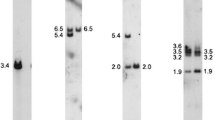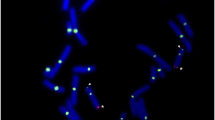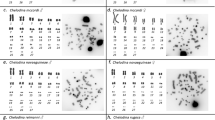Abstract
In the present investigation on the lizard Calotes versicolor, which lacks temperature-dependent sex determination, all the conventional cytological techniques used failed to resolve a distinguishable pair of sex chromosomes. However, probing of the genome with the human Y-linked genes SRY and ZFY showed sex-specific bias in their distribution. While the SRY probe hybridized to all the males, more than half of the females examined did not show any hybridization. ZFY hybridized to both the sexes, giving two bands; one was common to all the individuals of both sexes, but the other, of the lower molecular length, occurred in all the males but in less than 50% of females. This predominantly male-specific band is named AMF. The SRY-positive females were also positive for the AMF of ZFY. As positive as well as negative females were fertile and none of the males lacked SRY, it appears that SRY is essential for males only and that both the genes are syntenic in this species. This report raises interesting possibilities on the differentiation of the sex chromosomes in C. versicolor and evolution of SRY/ZFY on the Y chromosome of eutherian mammals through the ancestral group(s) that harbour sex-independent SRY- and ZFY-related genes.
Similar content being viewed by others
References
Arrighi FE, Hsu TC (1971) Localization of heterochromatin in human chromosomes. Cytogenetics 10: 81–86.
Bull JJ (1983) Evolution of Sex Determining Mechanisms. Menlo Park, California: Benjamin/Cummings.
Bull JJ, Hills DMH, O'Steen S (1988) Mammalian ZFY sequences exist in reptiles regardless of sex-determining mechanisms. Science 242: 567–569.
Burgoyne PS (1992) Y chromosome function in mammalian development. Adv Dev Biol 1: 1–29.
Charlesworth B (1991) The evolution of sex chromosomes. Science 251: 1030–1033.
Cole CJ (1975) Evolution of parthenogentic species of lizards. In: Reinboth R, ed. Intersexuality. Berlin: Springer-Verlag, pp 340–355.
Coriat AM, Muller U, Harry JL, Uwanogho D, Sharpe PT (1993) PCR amplification of SRY-related gene sequences reveals evolutionary conservation of the SRY-related motif. PCR Methods Appl 2: 218–222.
Coriat AM, Valleley E, Ferguson MWJ, Sharpe PT (1994) Chromosomal and temperature-dependent sex determina-tion: The search of a conserved mechanism. J Exptl Zool 270: 112–116.
Dubey DD, Raman R (1993) Mammalian sex chromosomes. IV. Replication heterogeneity in the late replicating facultative-and constitutive heterochromatic regions in the X-chromosomes of the mole rats, Bandicota bengalensis and Nesokia indica. Hereditas 115: 275–282.
Fletcher JM (1979) Light microscopic analysis of meiotic prophase chromosomes by silver staining. Chromosoma 72: 241–248.
Foster JW, Graves JAM (1994) An SRY-related sequence on the marsupial X chromosome: implications for the evolution of the testis-determining gene. Proc Natl Acad Sci USA 91: 1927–1931.
Ganesh S, Raman R (1995) Sex reversal by testosterone and not by estradiol or temperature in Calotes versicolor, the lizard lacking sex chromosomes. J Exptl Zool 271: 139–144.
Goodfellow PN, Lovell-Badge R (1993) SRY and sex determination in mammals. Annu Rev Genet 27: 71–92.
Griffiths R (1991) The isolation of conserved DNA sequences related to the human sex-determining region of Y gene from the lesser black-backed gull (Larus fuscus). Proc R Soc London B244: 123–128.
Gubbay J, Collignon J, Koopman P et al. (1990) A gene mapping to the sex-determining region of the mouse Y chromosome is a member of a novel family of embryonically expressed genes. Nature 346: 245–250.
Haaf T, Schmid M (1984) An early stage of ZW/ZZ sex chromosome differentiation in Poecilia sphenops var. melanistica (Poeciliidae, Cyprinodontiformes). Chromosoma 89: 37–41.
Jones KW, Singh L (1981) Conserved repeated DNA sequences in vertebrate sex-chromosomes. Hum Genet 58: 46–53.
King M (1990) Chromosomal and immunogenetic data: a new perspective on the Australia's reptiles. In: Olmo E, ed. Advances in Life Sciences: Cytogenetics of Amphibia ns and Reptiles. Basle: Birkhauser, pp 153–170.
King M, King D (1975) Chromosomal evolution in the lizard genus Varanus (Reptilia). Austral J Biol Sci 28: 89–108.
Koopman P, Ashworth A, Lovell-Badge R (1991a) The ZFY gene family in human and mice. Trends Genet 7: 132–136.
Koopman P, Gubbay J, Vivian N, Goodfellow PN, Lovell-Badge R (1991b) Male development of a chromosomally female mice transgenic for Sry. Nature 351: 117–121.
Lanfear J, Holland PWH (1991) The molecular evolution of ZFY-related genes in birds and mammals. J Mol Evol 32: 310–315.
Mengden GA, Stock AD (1980) Chromosomal evolution in Serpents: a comparison of G and C chromosome banding patterns of some colubrid and boid genera. Chromosoma 79: 53–64.
Mohanty J (1992) Cytogenetics of Lower Vertebrates: Molecular Sexing of Indian Lizards. Ph.D. Dissertation, Banaras Hindu University, Varanasi.
Moritz C (1990) Patterns of processes of sex-chromosome evolution in gekkonid lizards (Sauria: Reptila). In: Olmo E, ed. Advances in Life Sciences: Cytogenetics of Amphibians and Reptiles. Basle: Birkhauser, pp 205–219.
Nagamine CM, Chan K, Hake LE, Lau YFC (1990) The two candidate sex-determining Y genes ( Zfy-1 and Zfy-2) are differentially expressed in fetal and adult mouse tissues. Genes Dev 4: 63–74.
Nanda I, Raman R (1983) A simple method of staining the synaptonemal complex with coomassie brilliant blue for light microscopy. Stain Technol 58: 177–181.
Ohno S (1967) Sex Chromosomes and Sex Linked Genes. Berlin: Springer.
Olmo E, Odierna G, Capriglione T (1987) Evolution of sex-chromosomes in lacertid lizards. Chromosoma 96: 33–38.
Olmo E, Odierna G, Capriglione T, Cardone A (1990) DNA and chromosome evolution in lacertid lizards. In: Olmo E, ed. Advances In Life Sciences. Basle: Birkhauser, pp 181–205.
Page DC, Mosher R, Simpson EM et al. (1987) The sex determining region of the human Y chromosomes encodes a finger protein. Cell 51: 1091–1104.
Palmer MS, Sinclair AH, Berta P et al. (1989) Genetic evidence that ZFY is not the testis-determining factor. Nature 342: 937–939.
Raman R, Nanda I (1986) Mammalian sex chromosomes. I. Cytological changes in the chiasmatic sex chromosomes of the male musk shrew, Suncus murinus. Chromosoma 93: 367–374.
Sambrook J, Fritsch EF, Maniatis T (1989) Molecular Cloning: A Laboratory Manual. New York: CSH.
Schempp W, Schmid M (1981) Chromosome banding in Amphibia. VI. BrdU-replication patterns in Anura and demonstration of XX/XY sex chromosomes in Rana esculenta. Chromosoma 83: 697–710.
Schmid M, Nanda I, Steinlein C, Kausch K, Haaf T, Epplen JT (1991) Sex determining mechanism and sex chromosomes in amphibia. In: Green DM, ed. Amphibian Cytogenetics and Evolution. New York: Academic press, pp 393–430.
Sinclair AH, Berta P, Palmer MS et al. (1990) A gene from the human sex-determining region encodes a protein with homology to a conserved DNA binding motif. Nature 346: 240–244.
Singh L (1974) Study of mitotic and meiotic chromosomes in seven species of lizards. Proc Zool Soc Calcutta 27: 57–79.
Sumner AT (1972) A simple technique for demonstrating centromeric heterochromatin. Exp Cell Res 75: 304–306.
Tiersch TR, Mitchell MJ, Wachtel SS (1991) Studies on the phylogenetic conservation of the SRY gene. Hum Genet 87: 571–573.
Valleley EMA, Muller U, Ferguson MWJ, Sharpe PT (1992) Cloning and expression analysis of two ZFY-related zinc finger genes from Alligator mississippiensis, a species with temperature-dependent sex determination. Gene 119: 221–228.
Viets BE, Ewert MA, Talent LG, Nelson CE (1994) Sex determining mechanisms in squamate reptiles. J Exptl Zool 270: 45–56.
Author information
Authors and Affiliations
Rights and permissions
About this article
Cite this article
Ganesh, S., Mohanty, J. & Raman, R. Male-biased distribution of the human Y chromosomal genes SRY and ZFY in the lizard Calotes versicolor, which lacks sex chromosomes and temperature-dependent sex determination. Chromosome Res 5, 413–419 (1997). https://doi.org/10.1023/A:1018452526903
Issue Date:
DOI: https://doi.org/10.1023/A:1018452526903




